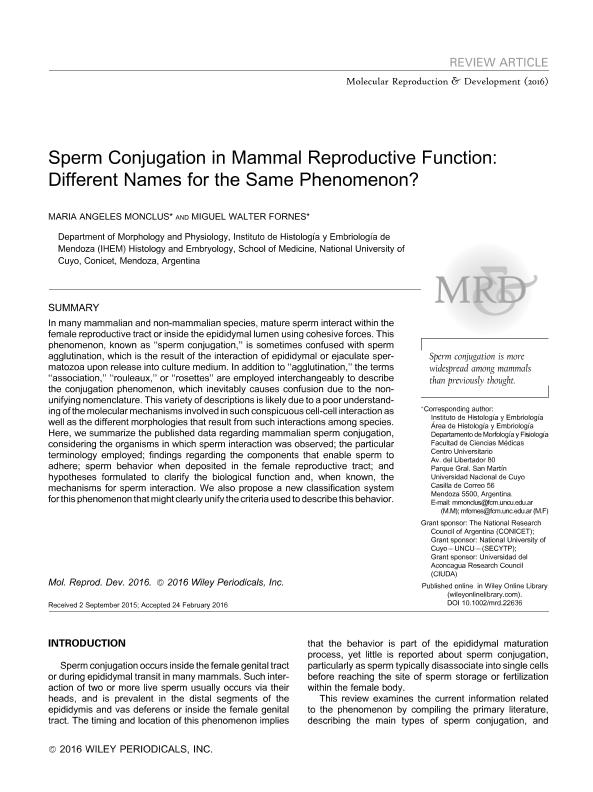Mostrar el registro sencillo del ítem
dc.contributor.author
Monclus, Maria de Los Angeles

dc.contributor.author
Fornes, Miguel Walter

dc.date.available
2018-06-15T21:57:54Z
dc.date.issued
2016-10
dc.identifier.citation
Monclus, Maria de Los Angeles; Fornes, Miguel Walter; Sperm conjugation in mammal reproductive function: Different names for the same phenomenon?; Wiley-liss, Div John Wiley & Sons Inc; Molecular Reproduction and Development; 83; 10; 10-2016; 884-896
dc.identifier.issn
1040-452X
dc.identifier.uri
http://hdl.handle.net/11336/48916
dc.description.abstract
In many mammalian and non-mammalian species, mature sperm interact within the female reproductive tract or inside the epididymal lumen using cohesive forces. This phenomenon, known as “sperm conjugation,” is sometimes confused with sperm agglutination, which is the result of the interaction of epididymal or ejaculate spermatozoa upon release into culture medium. In addition to “agglutination,” the terms “association,” “rouleaux,” or “rosettes” are employed interchangeably to describe the conjugation phenomenon, which inevitably causes confusion due to the non-unifying nomenclature. This variety of descriptions is likely due to a poor understanding of the molecular mechanisms involved in such conspicuous cell-cell interaction as well as the different morphologies that result from such interactions among species. Here, we summarize the published data regarding mammalian sperm conjugation, considering the organisms in which sperm interaction was observed; the particular terminology employed; findings regarding the components that enable sperm to adhere; sperm behavior when deposited in the female reproductive tract; and hypotheses formulated to clarify the biological function and, when known, the mechanisms for sperm interaction. We also propose a new classification system for this phenomenon that might clearly unify the criteria used to describe this behavior. Mol. Reprod. Dev. 83: 884–896, 2016
dc.format
application/pdf
dc.language.iso
eng
dc.publisher
Wiley-liss, Div John Wiley & Sons Inc

dc.rights
info:eu-repo/semantics/openAccess
dc.rights.uri
https://creativecommons.org/licenses/by-nc-sa/2.5/ar/
dc.subject
Espermatozoides
dc.subject
Conjugados de Espermatozoides
dc.subject.classification
Inmunología

dc.subject.classification
Medicina Básica

dc.subject.classification
CIENCIAS MÉDICAS Y DE LA SALUD

dc.title
Sperm conjugation in mammal reproductive function: Different names for the same phenomenon?
dc.type
info:eu-repo/semantics/article
dc.type
info:ar-repo/semantics/artículo
dc.type
info:eu-repo/semantics/publishedVersion
dc.date.updated
2018-06-13T16:51:59Z
dc.journal.volume
83
dc.journal.number
10
dc.journal.pagination
884-896
dc.journal.pais
Estados Unidos

dc.journal.ciudad
New York
dc.description.fil
Fil: Monclus, Maria de Los Angeles. Consejo Nacional de Investigaciones Científicas y Técnicas. Centro Científico Tecnológico Conicet - Mendoza. Instituto de Histología y Embriología de Mendoza Dr. Mario H. Burgos. Universidad Nacional de Cuyo. Facultad de Cienicas Médicas. Instituto de Histología y Embriología de Mendoza Dr. Mario H. Burgos; Argentina
dc.description.fil
Fil: Fornes, Miguel Walter. Consejo Nacional de Investigaciones Científicas y Técnicas. Centro Científico Tecnológico Conicet - Mendoza. Instituto de Histología y Embriología de Mendoza Dr. Mario H. Burgos. Universidad Nacional de Cuyo. Facultad de Cienicas Médicas. Instituto de Histología y Embriología de Mendoza Dr. Mario H. Burgos; Argentina
dc.journal.title
Molecular Reproduction and Development

dc.relation.alternativeid
info:eu-repo/semantics/altIdentifier/doi/http://dx.doi.org/10.1002/mrd.22636
dc.relation.alternativeid
info:eu-repo/semantics/altIdentifier/url/https://onlinelibrary.wiley.com/doi/abs/10.1002/mrd.22636
Archivos asociados
